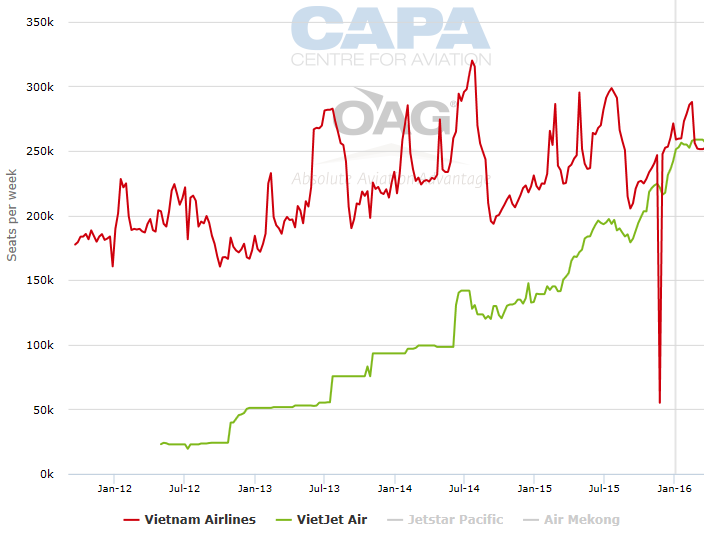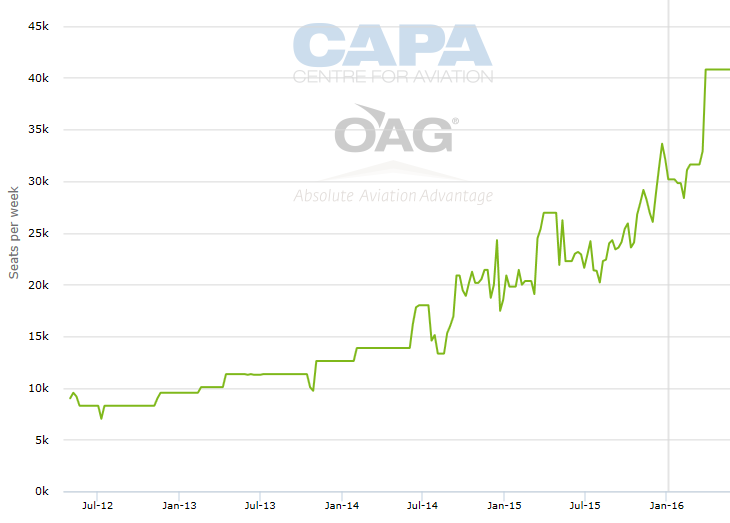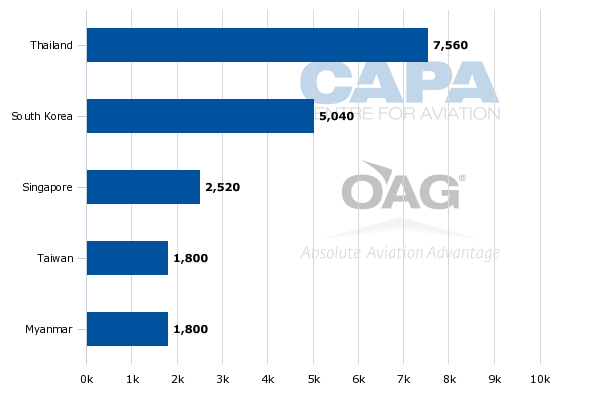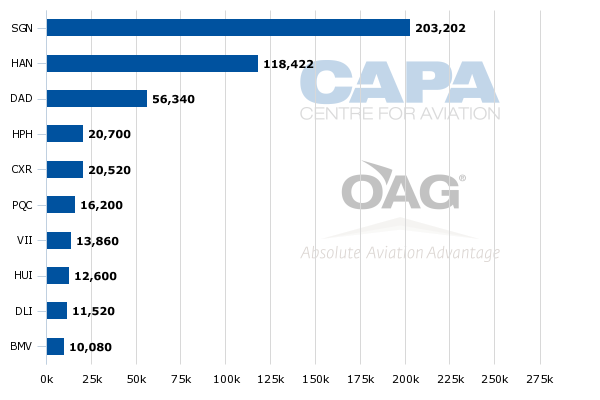VietJet Air 2016 outlook: overtakes Vietnam Airlines in domestic market as IPO planned for 1H2016
With an IPO expected in 1H2016, Vietnamese privately owned low cost carrier VietJet Air is planning more rapid expansion for 2016. This will result in further domestic market share gains and a larger international network. VietJet has quickly captured a 40% share of Vietnam's domestic market, and will likely surpass Vietnam Airlines in 2016 as Vietnam's largest domestic carrier.
International expansion has been modest in VietJet's initial four years, as the LCC has recognised that there are bigger and less risky opportunities domestically. Nevertheless, VietJet will continue to build up its international operation gradually in 2016, including the Feb-2016 launch of Hanoi-Taipei, which will become its eighth scheduled international route.
Faster international expansion is expected in the medium to long term, possibly using widebody aircraft, as the domestic market will eventually become saturated. A new reservation system that VietJet plans to decide on in 2016 will enable the LCC to start pursuing transit traffic, providing an important new source of international traffic as VietJet steps up marketing activities overseas.
VietJet carried 10 million passengers in 2015, targets 15 million for 2016
VietJet currently operates 28 domestic routes and seven international routes. It has quickly expanded since first operations in Dec-2011, capturing a 40% share of Vietnam's domestic market only four years after its launch.
About 10 million passengers were carried in 2015, with an average load factor of nearly 90%. Vietnam Airlines carried 17.4 million passengers in 2015, but only slightly more domestic passengers than VietJet.
VietJet passenger traffic was up approximately 70% in 2015, compared with the nearly 6 million passengers carried in 2014. VietJet tells CAPA it projects 50% passenger growth in 2016, to 15 million, as the group adds another 12 aircraft for a total of 42.
VietJet added nine aircraft in 2015
VietJet announced on 18-Dec-2015 that it had reached the 30 aircraft milestone, with the delivery of the eleventh aircraft from its Airbus commitment.
According to the CAPA Fleet Database, VietJet Air currently has 24 A320s and three A321s under its operating certificate, while its Thailand-based joint venture Thai VietJet operates one A320. The 30 aircraft figure includes two wet-leased aircraft that VietJet has been using for some time to provide supplemental capacity in the fast growing domestic market.
VietJet Air Group fleet summary: as of 4-Jan-2016
| Aircraft | In Service | In Storage | On Order |
|---|---|---|---|
| Total: | 28 | 0 | 88 |
| Airbus A320-200 | 25 | 0 | 4 |
| Airbus A320-200neo | 0 | 0 | 42 |
| Airbus A321-200 | 3 | 0 | 21 |
| Airbus A321-200neo | 0 | 0 | 21 |
VietJet Air added nine aircraft in 2015, including three A321s and six A320s. All nine aircraft were from its commitments with Airbus.
VietJet Air had also added nine aircraft in 2014, including the first two aircraft from the Airbus commitments and seven aircraft direct from leasing companies. (The group added 10 aircraft in total in 2014, as one aircraft was placed at Thai VietJet.)
VietJet fleet should reach 100 aircraft in 2021
VietJet placed its first new aircraft order in Feb-2014, when it signed commitments with Airbus at the 2014 Singapore Airshow for 63 A320 family aircraft. It signed commitments for 26 additional aircraft in 2015, including a six aircraft deal at the Paris Air Show in Jun-2015, and a 20 aircraft deal at the Dubai Air Show in Nov-2015. Of the combined 99 aircraft, VietJet has now taken 11 with 88 remaining on order.
An initial public offering, which was initially planned for 2015 and may now be completed in 1H2016, should help fund the rapid expansion of the VietJet fleet. VietJet should reach the 100 aircraft milestone in 2021, as its business plan has committed to 12 additional aircraft per annum.
Of the 11 aircraft already delivered from the Airbus commitment nine are currently owned by leasing companies, according the CAPA Fleet Database. The original 17 aircraft that were acquired prior to the first aircraft from the Airbus commitment were also from leasing companies (including the one aircraft at Thai VietJet).
Most of the original 17 aircraft were delivered as used aircraft. VietJet's oldest aircraft were built in 2006, and the average age of the group's current 28 aircraft fleet is slightly under four years (excluding the wet-leased aircraft).
VietJet plans to add 12 aircraft in 2016 - mostly A321s
VietJet plans to expand its fleet by 12 aircraft in 2016 and end the year with 42 A320/A321s, but the rate of deliveries will be slightly faster to offset aircraft that will be returned.
VietJet plans to return five A320s in 2016, all subleased from Philippine Airlines. As they come off sublease, Philippine Airlines plans to return these aircraft as their leases are expiring.
Most of VietJet's 2016 deliveries will be A321s. The group currently has only four outstanding A320ceo commitments compared with 21 A321ceo commitments. Its orders for the new generation A320neo family is evenly split between 21 A320neos and 21 A321neos but at least some of the A320neos will likely be converted to A321neos prior to delivery, as part of VietJet Air's upgauging strategy.
As CAPA has previously highlighted, VietJet Air is focusing fleet expansion on the new high density 230-seat version of the A321 as it tries to maximise slots at Vietnam's main airports. The use of the A321 on trunk routes also enables VietJet to reduce its unit costs and meet fast growing demand.
See related report: SE Asian LCCs: up-gauging to high density narrowbody aircraft will impact capacity - and order books
The upgauging will enable VietJet to maintain a rapid rate of capacity expansion in 2016. In 2015, the VietJet Air fleet expanded from 20 A320s to 26 A320s and three A321s (this includes the wet-leased aircraft but excludes the aircraft at Thai VietJet).
The total number of seats in the fleet expanded by 49% in 2015, from 3,600 seats at the beginning of the year to 5,360 seats at the end of the year. All of VietJet's A320s are in 180 seat configuration, while two of the A321s are in the newly available high density 230-seat configuration, and one has the old maximum of 220 seats.
The VietJet Air fleet will likely end 2016 with 8,170 seats, which would represent expansion of 52%. This figure is based on 12 growth A321s plus five A320s being replaced with four A320s and one A321. The rate will be even faster if VietJet takes A321s entirely, but will be slower if VietJet allocates some of its 2016 deliveries to Thai VietJet. (Additional aircraft for Thailand are not expected until, and unless, the new airline is cleared to operate scheduled services.)
VietJet could overtake Vietnam Airlines as Vietnam's largest domestic carrier in Mar-2016
Even assuming a conservative scenario, VietJet Air should be able to meet its goal of growing passenger traffic by 50% in 2016.
As CAPA outlined in a 2-Jan-2016 report on the overall Vietnamese market, VietJet's total seat capacity is currently up 74% year over year to about 261,000 weekly seats. This includes an 82% increase in the domestic market to about 242,000 weekly seats, and a 30% increase in the international market to about 19,000 weekly seats. Only about 7% of VietJet's seat capacity is currently allocated to the international market.
See related report: Vietnam aviation: SE Asia's fastest growing market in 2015 as VietJet Air & Jetstar Pacific expand
VietJet is planning further domestic expansion in the coming months, which will see it supercede Vietnam Airlines as the largest domestic carrier. Based on forward schedules from OAG, VietJet's domestic capacity will reach almost 259,000 weekly seats in Mar-2016, which represents a 7% increase compared to current levels, and a 73% increase compared to Mar-2015 (therefore keeping up its current very high year over year expansion rate).
Based on forward schedules currently on file with OAG, VietJet will have more domestic capacity in Mar-2016 than Vietnam Airlines, for the first time in its history. (Vietnam Airlines could still potentially add capacity to its Mar-2016 schedule, as Vietnamese carriers often make last second adjustments.)
VietJet and Vietnam Airlines domestic weekly seat capacity: Sep-2011 to Mar-2016
Based on the current schedule for Mar-2016, VietJet will have about a 43% share of domestic seat capacity compared with 42% for Vietnam Airlines, and 15% for Vietnam Airlines LCC subsidiary Jetstar Pacific. Currently VietJet has about a 40% share compared to 45% for Vietnam Airlines and 15% for Jetstar Pacific.
VietJet will again focus expansion on domestic trunk routes
VietJet is expected to continue adding domestic capacity throughout 2016, with a focus on trunk routes.
On Ho Chi Minh-Hanoi, VietJet is planning a 35% capacity increase over the next three months, which will also enable it to become the market leader on Vietnam's largest route. VietJet's share of seat capacity on Ho Chi Minh-Hanoi is now expected to reach almost 50% in Apr-2016, compared with 40% currently.
VietJet one way weekly seat capacity on Ho Chi Minh-Hanoi: Sep-2011 to May-2016
As CAPA highlighted in the last report, Ho Chi Minh-Hanoi is now the seventh largest route in the world and recorded the fastest growth over the last year among the global top 10 largest routes. VietJet seat capacity on Ho Chi Minh-Hanoi is currently up 73% year over year, while the total route has seen a 24% capacity increase.
VietJet has also increased capacity over the last year by at least 29% on all top 10 of its domestic routes. More increases are planned for 2016 across nearly all trunk routes, as VietJet aims eventually to capture a 50% share of the Vietnam's domestic market.
VietJet Air top 10 domestic routes ranked by seat capacity, with year over year increases
| Rank | Origin | Destination |
Current Seats |
Y-o-Y change |
||
|---|---|---|---|---|---|---|
| 1 | SGN | Ho Chi Minh City Tan Son Nhat Airport | HAN | Hanoi Noi Bai Airport | 63,850 | +73% |
| 2 | SGN | Ho Chi Minh City Tan Son Nhat Airport | DAD | Da Nang Airport | 31,876 | +70% |
| 3 | HAN | Hanoi Noi Bai Airport | DAD | Da Nang Airport | 18,016 | +61% |
| 4 | SGN | Ho Chi Minh City Tan Son Nhat Airport | HPH | Hai Phong Cat Bi Airport | 15,660 | +50% |
| 5 | SGN | Ho Chi Minh City Tan Son Nhat Airport | HUI | Hue Phu Bai Airport | 12,600 | +29% |
| 6 | SGN | Ho Chi Minh City Tan Son Nhat Airport | PQC | Phu Quoc International Airport | 11,160 | +48 |
| 7 | SGN | Ho Chi Minh City Tan Son Nhat Airport | VII | Vinh City Airport | 10,620 | +47% |
| 8 | SGN | Ho Chi Minh City Tan Son Nhat Airport | CXR | Nha Trang Cam Ranh Airport | 9,360 | +93% |
| 9 | HAN | Hanoi Noi Bai Airport | CXR | Nha Trang Cam Ranh Airport | 9,180 | +48% |
| 10 | SGN | Ho Chi Minh City Tan Son Nhat Airport | THD | Thanh Hoa Airport | 7,560 | +200% |
VietJet to add Tuy Hoa as its 17th domestic destination
VietJet will also continue to launch new domestic routes in 2016, although the new routes will account for a relatively small portion of the total additional capacity, since they are generally thin low frequency routes.
VietJet launched eight new domestic routes in 2015, none of which are currently served with more than two daily flights. VietJet has already announced three new domestic routes that will be launched in mid Jan-2016, including four times weekly Pleiku-Hai Phong service, three times weekly Pleiku-Vinh service, and daily Ho Chi Minh City-Tuy Hoa service.
Pleiku was one of three domestic destinations that VietJet added in 2015, and is currently served from Ho Chi Minh and Hanoi. Tuy Hoa will become a new destination for VietJet on 20-Jan-2016, extending the VietJet domestic network to 17 destinations and 31 routes (compared with 16 destinations and 28 routes currently).
Ho Chi Minh-Tuy Hoa is currently only served by Jetstar Pacific, which took over the route from its full service parent Vietnam Airlines in 2015. Tuy Hoa is the only domestic destination currently served by Jetstar Pacific but not by VietJet.
VietJet continues to expand its international network slowly
In Vietnam's international market VietJet currently has less than a 4% share of international seat capacity. VietJet currently has only five scheduled international destinations - Bangkok, Singapore, Seoul, Taipei and Yangon. Bangkok and Seoul are now served from both Ho Chi Minh and Hanoi while Singapore, Taipei and Yangon are currently only served from Ho Chi Minh.
VietJet has been focusing primarily on connecting the dots by launching new routes to existing international destinations. Ho Chi Minh-Seoul was added in Nov-2015, supplementing Hanoi-Seoul.
VietJet's first new international route for 2016 will be Hanoi to Taipei. Thrice weekly Hanoi-Taipei service will be launched on 15-Feb-2016 supplementing Ho Chi Minh Taipei, which is currently served with five weekly flights but is being upgraded to daily.
VietJet is also reportedly looking at launching services from the Vietnamese beach resort city of Nha Trang to Seoul in Feb-2016, but new routes from Nha Trang will most likely operate as seasonal charters. VietJet already operates several international charter routes from Nha Trang and Da Nang, primarily to China.
VietJet's business plan for 2016 proposes an expanded charter operation to China and the potential launch of scheduled flights to China. VietJet is also aiming to launch scheduled flights to Japan in 2016, a market it has also only served with limited charters, so far.
In addition Hong Kong will be launched in 2016, but only if VietJet can succeed at securing slots at Hong Kong, where till now efforts have not succeeded.
Korea, Taiwan, China and Japan expansion would be relatively low risk for VietJet
Other new destinations under evaluation for 2016 include Busan and Jeju in South Korea, and Kaohsiung in Taiwan. While these would be new destinations, the risk would be relatively low, since VietJet already has a presence in these countries.
VietJet international scheduled international seat capacity by country: 4-Jan-2016 to 10-Jan-2016
VietJet has developed relationships with agents in South Korea and Taiwan as these are primarily inbound markets for Vietnam. The Bangkok, Singapore and Yangon routes cater more to outbound Vietnamese passengers, a sector VietJet can more easily target given its strong domestic presence.
VietJet also has relationships with Chinese and Japanese agents through its charter programme. Having these relationships makes it easier to operate scheduled flights to China and Japan, which would rely heavily on inbound passengers.
VietJet seeks to build up its brand outside Vietnam and attract transit traffic
VietJet still has a generally unknown brand overseas. But the LCC is keen to build up its awareness in foreign markets, and it recently began an advertising campaign on CNN.
A stronger international brand should help VietJet attract more inbound tourists on its growing international network, as well as on its domestic flights, as tourists typically visit more than one region of Vietnam. It will also help VietJet start to attract transit passengers, an area it is keen to pursue as it further develops its international network.
VietJet does not currently offer a transit product; it is unable to sell connecting city pairs, even using a sum of sector formula, because it has been using a simple reservation system since its 2011 launch. However, VietJet is currently evaluating a new reservation system, and plans to select a supplier within the next few months. The new reservation system will support a transit product, including connections to flights operated by Thai VietJet.
The Thai VietJet business plan focuses heavily on offering connections to VietJet passengers arriving in Bangkok from Vietnam. Domestic destinations within Thailand such as Chiang Mai and Phuket are planned as well as international destinations to the west such as Myanmar and India. For now, Thai VietJet is unable to offer such connections as it is on the same limited reservation system as its parent.
Thai VietJet has only operated limited charters since it launched operations in late 2014, following a much longer than expected certification process. In early 2015 Thai VietJet was aiming to launch scheduled services in Mar-2015. As late as Nov-2015 it was still hoping to launch scheduled services by the end of 2015 - but continues to be set back by delays. Given the intense competition in the Thai market the group at this point could best drop the Thailand project entirely and focus on Vietnam, where there is relatively limited competition and huge opportunities for growth.
VietJet could start to partner with foreign carriers
The new reservation system to be acquired by VietJet in 2016 will also support interlines and codeshares with carriers outside the VietJet Group. VietJet currently does not have any airline partners, but its domestic network would be attractive to several foreign carriers serving Vietnam, particularly carriers outside SkyTeam. Vietnam Airlines, Vietnam's only full service carrier, is a SkyTeam member.
VietJet has already hybridised in 2015 by introducing a premium product, Skyboss, which has enabled the LCC to penetrate the local corporate market, particularly small and medium size companies. Skyboss gives VietJet a potential platform for working with foreign full service carriers and attracting international corporates.
Skyboss provides a preferred seat at the front of the cabin with extra legroom, meals, lounge access, ticket change flexibility and priority boarding, including a separate bus to the aircraft for bus gates. Up to six rows can be sold under Skyboss, depending on demand, as the curtain is movable and the seats are the same width as economy.
VietJet could launch longer international routes
VietJet has previously looked at accelerating international expansion by acquiring widebody aircraft. While VietJet will likely relook at widebodies at some point, maintaining a single aircraft type is sensible for now.
There are still opportunities for VietJet to expand internationally using A320 family aircraft. Most of Asia is within the range of the A320ceo, and the new generation A320neo family will open up even more Asian options for VietJet. For example, Tokyo can be reached from Hanoi with the A320ceo but can also be reached from Ho Chi Minh with the A320/A321neo.
The airline has already ordered the A320neo and A321neo and has been evaluating the A321neoLR. The A321neoLR would enable VietJet to operate even longer international routes, such as Brisbane.
But for at least the short to medium term the most attractive opportunities remain in the domestic market. Vietnam has been one of the fastest growing domestic markets in the world over the last couple of years and will again see rapid growth in 2016. A booming economy and an expanding middle class have made for ideal conditions, particularly for LCCs, as low fares continue to persuade a growing proportion of Vietnamese citizens to trade long bus or train journeys for domestic flights.
Further domestic expansion in 2016 is strategically important for VietJet
Domestic competition is now intensifying, putting pressure on yields that were already low. However VietJet needs to maintain rapid domestic growth for strategic reasons as it seeks to further increase its market share, despite accelerated expansion at LCC rival Jetstar Pacific.
Strategically, more flights across trunk routes are also a smart move as there is now an opportunity to secure the final batch of daytime slots at Vietnam's main airports before infrastructure constraints start limiting expansion. VietJet can always add international flights later by using late night slots and reallocating some domestic slots, particularly as it will be able to continue expanding domestically without necessarily adding flights by upgauging to higher capacity aircraft.
Vietnam's main airports will eventually be expanded. In some cases, such as in Ho Chi Minh, new airports will eventually open, but several years of slot constraints are a distinct possibility. VietJet expects infrastructure constraints to emerge over the next few years at all three of its current bases - Ho Chi Minh (SGN), Hanoi (HAN) and Da Nang (DAD) - and is now looking at potentially opening bases at secondary cities, starting with Hai Phong (HPH) in 2016.
VietJet top 10 bases/stations ranked by weekly seat capacity: 4-Jan-2016 to 10-Jan-2016
2016 is the time to grab as many prime slots as possible and make another big domestic push.
Faster international expansion can always be pursued later.



